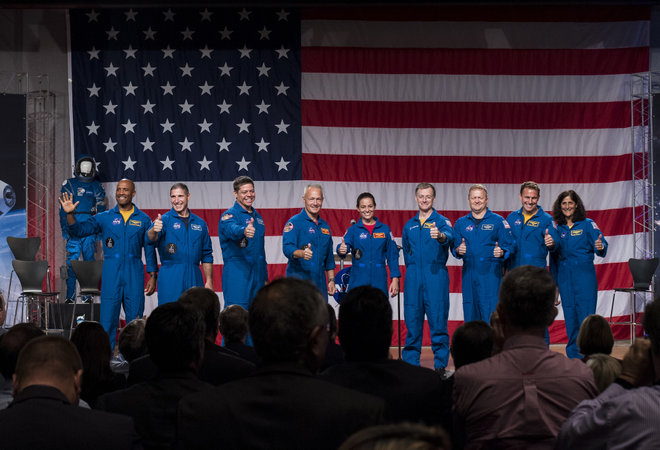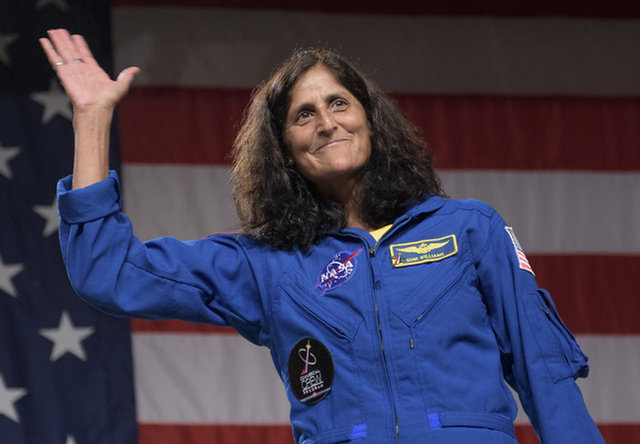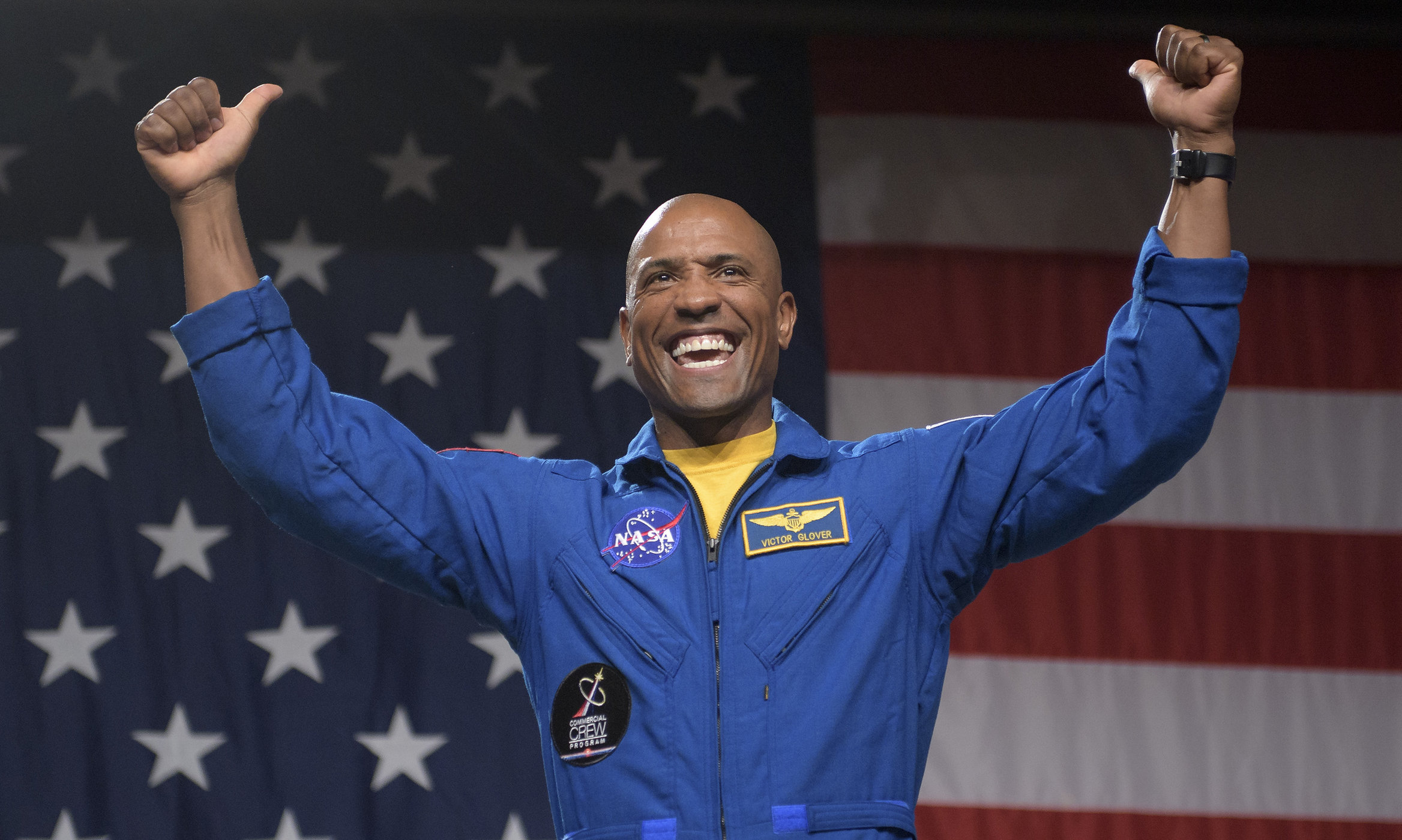Formed crews for spacecraft Boeing and SpaceX
- Transfer

August 3, 2018 in the NASA Space Center named after Lyndon Johnson, Houston, the nine astronauts were introduced to the public, who were the first to go into space on new spacecraft produced by American private corporations. From left to right: Victor Glover, Mike Hopkins, Bob Benken, Doug Harley, Nicole Onapa Mann, Chris Fergusson, Eric Bow, John Kassad and Sune Williams. They are selected by the agency for test flights and manned missions of the Boeing CST-100 Starliner and SpaceX Crew Dragon. Photo source: Bill Ingalls / NASA
HOUSTON - from now on call them "Commercial Team Nine." NASA solemnly announced the names of those who fly in private spacecraft built by SpaceX and Boeing; there was even a phrase that it was “the guys what was needed” - once, in 1959, the first set of American astronauts, “Seven of the“ Mercury ”, said so.
The announcement was conducted yesterday (August 3) at the NASA Lyndon Johnson Space Center; before a crowd of congressmen, officials of various ranks and children waving stars and striped flags, eight people from NASA and one from Boeing finally appeared. They will again go into orbit from launch sites in the US, which has not happened since the shutdown of the Shuttle program in 2011.
"This is a huge success for our country, and we want to convey to every American - we are back in the saddle," said agency administrator Jim Brydenstein, "We are launching astronauts on American rockets from America." [ Meet the SpaceX and Boeing crews ]
Perhaps, hardly any event is awaited with such impatience as the Boeing and SpaceX test manned flights. So far, four flights to the ISS have been planned for 2019 - two on Crew Dragon and two on CST-100 Starliner - immediately after unmanned launches will end.
On the CST-100 will fly first: from NASA - Eric Bow, Nicole Onapa Mann; from Boeing - Chris Fergusson. Fergusson is a former agency astronaut and commander of the Shuttle crew who transferred to Boeing to work on the Starliner program. If everything goes according to plan, their mission will take place in mid-2019.

Astronaut Suni Williams welcomes the public after they have named her name among the participants of the “Commercial Team Nine” on August 3, 2018. Photo source: Bill Ingalls / NASA NASA
veterans Bob Benken and Doug Harley will be the first to fly to Crew Dragon. Their mission is scheduled for April 2019.
“Without a doubt, such an opportunity falls once in a lifetime,” says Nicole Mann, a former lieutenant of the Marine Corps, who came to NASA only in 2013. “There is nothing better than becoming a test pilot.”
Harley agrees with her: “To go on the first flight on an absolutely new technique is a dream for any test pilot, and it always seems that this will never happen to you. Well, as you can see, it still happens. ”
After the successful completion of the test manned flights, two more crews will go to the ISS for a long-term stay. Onboard Starliner will be another NASA veteran Sunita Williams (former crew commander on the ISS) and rookie John Kassad. Dragon will take veteran Mike Hopkins to the station along with another newcomer, Viktor Glover.
Yeah, the guys have come a long way for this moment. Long in years, in fact.
It all started in September 2014, when the agency first announced the delivery of astronauts to the ISS and back with the assistance of SpaceX and Boeing. Then SpaceX Crew Dragon (known at the time, Dragon V2) and Boeing Starliner (at that time just CST-100) won the competition lasting four years - and got contracts for billions of dollars - in order to send people into space. [A tour of the SpaceX Crew Dragon ship ]
Then, in July 2015, NASA gave up another news item, selecting four for training on the Dragon and Starliner: these were Bow, Benken, Harley and Williams . Since then, astronauts, in addition to working at NASA, have additionally trained at SpaceX and Boeing.
Yesterday’s statement is an important milestone for the American space program, symbolizing America’s return to self-piloted flights. The last mission of the shuttle, STS-135 under the command of Fergusson, took place back in July 2011. Since then, NASA has been forced to rent space on the Russian "Unions", paying about $ 70 million per unit.
Some newcomers, like Kassada, joined NASA with the expectation to fly at least on the Soyuz before any American ship appeared. "But I will tell you: to be able to fly to the ISS from the American land is just an indescribable feeling," Kassad rejoices.
Glover, who also came to NASA only in 2014, simply said: "All this is like a dream come true ... the embodiment of the test pilot's most violent fantasies."

Astronaut Victor Glover, "Commercial Team Nine." Photo source: Bill Ingalls / NASA
Crew Dragon starts on a Falcon 9 PH, and both devices allow reuse. The CST-100 is also planned to be reused, and it will be launched using the Atlas V PH from the United Launch Alliance. SpaceX set a goal to conduct an unmanned test flight in November of the current year, and the same event at Boeing is on schedule at the end of 2018 and the beginning of 2019. [ How does the Boeing CST-100 Starliner work ]
Although, of course, the timing can move. In truth, they have literally moved this week.
At the beginning of the year, NASA published a plan according to which the unmanned flights of the CST-100 and Crew Dragon were to take place just in August; the first manned missions were expected at the end of 2018. But on Thursday, August 2, it became known about the change of dates.
According to the updated schedule, SpaceX conducts an unmanned flight in November of the current year, followed by a manned flight in the spring of 2019. Boeing, in turn, hopes to carry out an unmanned flight in late 2018 and early 2019, and manned - in mid-2019. So far, American astronauts will continue to fly to the ISS on the Russian "Soyuz".
Regardless, NASA, SpaceX and Boeing regularly focus public attention on the fact that ships will fly only when they are certainly ready.
The President of SpaceX, Gwen Shotwell, just slightly touched this topic during the presentation of the crews. Executive director Ilon Mask, she said, founded the company in 2002 primarily to build the most reliable and safe space technology.
“Seven thousand SpaceX employees, like us, take, like a great honor, the opportunity to become a part of all this, to take you into orbit,” Shotwell said to the nine “And we are serious. We will not let you down. ”
